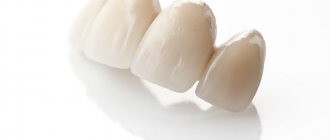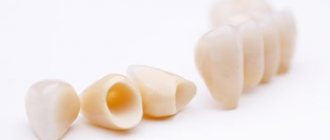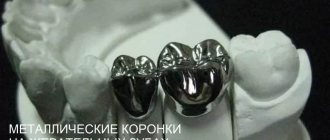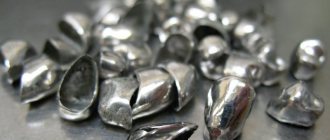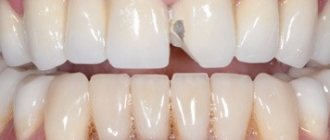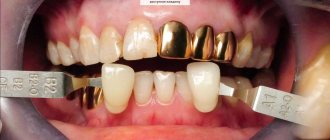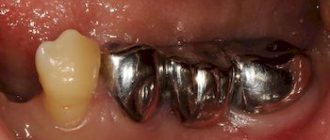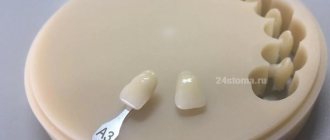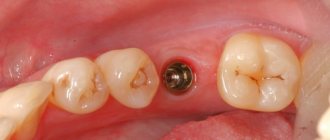Suction cup prostheses
Suction cup prostheses are the classic and oldest option. The structure is fixed by putting it on the gums and, as it were, sticking to them. This option is suitable if several teeth in a row or all elements of the dentition are missing.
Modern orthopedic dentists offer patients the following options for removable dentures:
- Acrylic. This option is the most budget-friendly and reliable. The hardness of acrylic is a guarantee of reliable fixation. But due to rigidity and friction against the gums, discomfort may occur.
- "Acry-Free" These prostheses are created from acrylic resins that do not contain allergenic substances. Such designs are light, smooth, and suitable for eliminating various defects, including edentia (the absence of all teeth).
- Nylon structures are affordable, made from elastic and non-rigid nylon, have a quick adaptation period and cause minimal discomfort.
For your information! The denture can be complete or partial, with free openings for remaining teeth.
Butterfly dentures
Butterfly-type structures are called immediate prostheses: the product has a base with two wing-shaped sections extending from it. Such “wings” are fixed on the supporting dental units. But this option is used as a temporary one, for example, during the production of permanent dentures. The “butterfly” will allow you to visually eliminate the defect and get used to the prosthetic structure.
Clasp dentures
The clasp prosthesis in its design has three main elements: a metal arch-base, artificial teeth and hooks (telescopic crowns or clasps), with which the clasp is fixed to the supports (preserved teeth). The version for the upper jaw has a palatal bridge.
The design can replace one to several lost teeth. The presence of a frame guarantees even distribution of the load, and hooks make the fixation reliable.
Good to know! A separate type of clasp structures are “Quadrotti” (“Quattro Ti”), in which the metal arch is replaced by a lightweight and hypoallergenic frame made of high-quality soft material. The hooks-retainers are also made from it.
Dentures with locks
A modern solution is dentures with locks, which are fixed using attachments - special locking elements consisting of two parts. One fragment is in the structure, and the second part is fixed in the ground tooth (or root) or in the crown. The attachment elements snap into place and prevent the prosthesis from moving. Since fixation requires special skills, this option can be considered conditionally removable.
Removable dentures on implants
Such dentures are fixed on the jaw using implants implanted into the bone structures - small pins onto which the structure is placed for the most reliable fastening.
New generation removable dentures
Lower or upper removable denture without palate - developed by a Moscow dentist. Otherwise, this type is called a “sandwich”, since the body is a combination of two layers - elastic polyurethane and acrylic hard plastic.
The base (the base that is fixed on the jaw) of the new generation sandwich prosthesis is made of pink hard acrylic material. In this part, artificial dental elements are fixed. And in areas where the patient has retained his own teeth, the product has so-called telescopic crowns. They are made of a plastic and soft polyurethane composition, which covers the preserved dental elements and reliably fixes the prosthesis on them.
Fixed dentures
Fixed dentures are indicated for:
- loss of all teeth;
- the absence of one or more teeth that are surrounded by absolutely healthy elements (implantation preserves their original state);
- creating a support for the further installation of a bridge structure (healthy teeth are not ground down and remain intact);
- loss of anterior incisors;
- inability to use removable dentures (gum disease, atrophy of their tissues);
- reluctance to use removable structures due to discomfort, pain or fear of accidental displacement.
Fixed dentures are securely fixed, restore full chewing and speech functions, maintain bite, serve for a long time and allow you to achieve the best aesthetic effect.
Crowns
Crowns restore damaged or partially destroyed elements of the dentition. Dentures are installed on the preserved parts of the teeth to avoid their complete removal. Crowns can be zirconia, metal-ceramic, ceramic-composite, ceramic.
Helpful information! To install a crown, the nerve is removed and the tooth is ground down to a stump.
Implants
Implants restore teeth completely, including the root zones. Implantable dentures are implanted into the bone tissue and become an integral part of the jaw, which allows for the most reliable fixation:
There are the following types of implants:
- Lamellar intraosseous (endosseous). The base has a plate configuration with a large area of contact with the jaw bone. This option is relevant for a deficiency of native bone tissue.
- Root-like. These prostheses are screw or cylindrical, repeating the anatomical structure of the tooth with the root part. For installation, sufficient volumes of bone tissue are required (if there is a shortage, augmentation can be performed).
- Intramucosal. This type is applicable if atrophy of the alveolar process is diagnosed, but the patient has sufficient thickness of the mucous membrane (from 2 mm).
- Subperiosteal. This is a complex metal complex that is placed under the gums and is used for atrophy and bone deficiency (for example, in older people).
Microprostheses
Microprostheses are structures that partially restore teeth, only damaged areas. There are two varieties:
- Lumineers and veneers take the form of thin plates that are fixed to the teeth and restore aesthetics. The therapeutic effect is not achieved, but various external defects are masked: chips, pigmented areas, scars, cracks, diastemas. Veneers are made from biocompatible compounds: composite materials, zirconium dioxide, ceramics.
- Inlays resemble classic fillings, but are made from durable materials using individual impressions. The element is installed in the damaged area, closing the open dental cavity and restoring the natural structure of the tooth.
Bridge structures (bridges)
A bridge is a rigid structure consisting of two base crowns and artificial dental elements located between them. Bridges are fixed either on supporting natural teeth or on implants implanted into the jaw.
The maximum bridge section (“span”) can include 3-4 teeth, that is, the main indication for using a bridge is the absence of one to 4 elements in the dentition (1 chewing element, no more than 4 incisors or two premolars). In this case, there must be supports on both sides: your own preserved teeth or implants.
Bridges are:
- soldered (stamped), made by soldering individual elements (two support crowns and a bridge);
- solid cast, having a single design;
- combined adhesive, devoid of supporting crowns and having a fiberglass/metal-ceramic arch, which plays the role of a load-bearing fragment and the ends rest against the holes (they are formed in adjacent dental elements).
According to the method of placement, bridge structures are divided into tangent, saddle and flush. The latter leave space between the gum and the denture to wash out food particles. The tangent model has contact with the gingival surface at the front. The saddle bridge touches the gums on both sides (anterior and posterior)
Metal ceramics on the front teeth –
An aesthetic problem when replacing anterior teeth with metal-ceramics is associated with the presence of a metal frame under the surface layers of the ceramic mass. The first problem is that the ceramic layer must be made opaque - otherwise the metal frame will be visible through the ceramic layer. In turn, dental tissues have a certain light transmittance - enamel is capable of transmitting about 70% of light, and the dentin lying under the enamel is about 30%.
Such optical properties give natural teeth a certain degree of transparency, as well as color, which also changes from the cutting edge to the neck of the tooth. Therefore, when metal-ceramic crowns are installed on one or two front teeth, in most cases they are noticeable against the background of natural teeth. Therefore, if we are talking about budget metal-ceramics, this problem can be more or less solved only if you install metal-ceramics on all 6-8 front teeth at once, and in this case, all the front teeth under the crowns will look at least the same.
If you have a sufficient budget, the problem of color and transparency can be solved by using more expensive ceramic mass, the use of which, however, will significantly increase the cost of crowns. Among the best options (according to many of our colleagues) are the ceramic masses “Vita” (Germany) and “Noritake” (Japan), as well as “Ivoclar” (Liechtenstein). The use of a good ceramic mass allows us to minimize the difference between metal-ceramics and natural teeth, but again, only to a certain extent.
Clinical case No. 1 (before and after photos) –
In Fig. 3-4 you can see how one terrible metal-ceramic installed on all the upper teeth was replaced with almost the same terrible one (the crowns look gray, there is no gradient of color and transparency; as if they were made of plastic). More or less, the only thing that saves the situation is that all the upper teeth look the same, because... They all have the same crowns. In fact, in this case, metal-ceramics are more like cheap plastic crowns.
Clinical case No. 2 (before and after photos) –
In Fig. 5-6 you can see that all 6 lower metal-ceramic crowns - 1) have an unnatural gray-milky color, which is especially visible on the fangs, 2) there is no transparency along the cutting edge, 3) there is no color transition from the neck of the tooth to the cutting edge . The situation is saved again only by the fact that all 6 front teeth are taken under crowns - which makes them at least identical. On the other hand, we must admit that many patients are quite satisfied with this level of aesthetics.
Important: it should also be noted that the transparency of tooth enamel can vary greatly from person to person. Therefore, if the enamel is highly transparent, metal ceramics will not suit you at all. But if your teeth have low enamel transparency, then high-quality metal-ceramics may be a good option. But in any case, keep in mind that in bright natural light, the difference in color and transparency between metal-ceramic crowns and “your teeth” will be most noticeable. It is also worth considering that metal ceramics will have a stronger effect in patients with a gummy type of smile, i.e. when the crowns of the teeth are completely exposed when smiling.
Another disadvantage of metal ceramics on the front teeth –
However, the lack of a gradient of color and transparency (which can be found in most cases of manufacturing budget metal ceramics) is not its only aesthetic problem. Many patients almost immediately after prosthetics note that the gums around the crown have become bluish (Fig. 7). Also, after several years, many patients notice that the gums have receded, exposing the subgingival edge of the crown at the neck of the tooth - which looks like the “dark line” in Fig. 8.
Disadvantages of economy class metal ceramics:
Patients react calmly to such things if they occur in the area of the chewing teeth. But on the front teeth, especially if the patient has a gummy type of smile (that is, the gums are exposed while smiling) - this is a serious aesthetic problem. All this arises due to the fact that the lower edge of the metal frame of a metal-ceramic crown is usually not insulated with ceramic mass. It is the contact of the metal with the gum that leads to a change in its color, and also contributes to gum recession and exposure of the edge of the crown.
However, such problems with gum aesthetics are typical only for standard economy-class metal-ceramic crowns. There are metal-ceramic crowns with a much higher level of aesthetics - the so-called metal-ceramics of increased aesthetics.
Metal ceramics of increased aesthetics –
To create high-quality, highly aesthetic metal-ceramics, you certainly need an expensive, high-quality ceramic mass, which will significantly increase the cost of such crowns.
However, this is not enough, because in order to also exclude the appearance of cyanosis of the gums or a dark line, it is necessary to manufacture metal-ceramics with “shoulder mass” (Fig. 9). For crowns with shoulder mass, the metal frame will be insulated with ceramics, including in the area of the ledge (where the crown wraps around the neck of the tooth), i.e. slightly below the edge of the gum. Moreover, isolation can be carried out either along the entire perimeter of the cervical part of the crown, or only on its front side, which is already good. Isolating the edge of the metal frame with ceramics helps to avoid the development of cyanosis of the gums and the appearance of a dark line in the future.
Clinical case No. 3 – before and after photos
In Fig. 10-11 we see a decent option for metal-ceramic prosthetics, which was installed on the 4 upper incisors (there is even transparency along the cutting edge). Additionally, the patient had teeth whitening. As we can see, there are practically no differences in the color and transparency of metal-ceramic crowns from your own teeth (although minor flaws will still be noticeable to professionals).
It should be noted that modern metal-ceramic crowns (thanks to the latest generation of ceramic compounds) can be almost as aesthetically pleasing as ceramic ones. But this requires expensive materials, and most importantly, a highly professional dental technician who must have artistic talent. And there are only a few such technicians even in Moscow and St. Petersburg. And in any case, the cost of 1 unit of highly aesthetic metal ceramics (in clinics where the best specialists work) will be no less than 25,000 rubles.
Which dentures are better?
To find the best dentures, the main evaluation criteria should be identified. Patients and doctors refer to them as:
- Load distribution. There should be no painful or uncomfortable sensations during chewing.
- Hypoallergenic. A good and high-quality prosthesis does not cause unwanted reactions in the form of irritation, itching and redness of the palate, gums, tongue and inner surface of the lips.
- Strength. The frame should not look fragile.
- Reliability of fixation. The denture should not wobble during installation, and should not move during chewing.
- Durability. If the previous four criteria are met, removable dentures can last a maximum of 5 years, and fixed structures can last up to 15-20 years.
- Durability of the initial shade. The denture should not fade or be stained by drinks or foods consumed.
Prosthetics with zirconium crowns –
The next option for aesthetic prosthetics of the front teeth is ceramic crowns made of zirconium dioxide (such crowns are called zirconium). This material has the strength of metal, and therefore crowns made from it do not require an internal metal frame. The absence of the latter should certainly provide more aesthetic options when using prosthetics with zirconium crowns, but in reality, not everything is so simple, and you can find a huge number of patients who are dissatisfied with such prosthetics.
Let's start with the fact that there are 2 types of zirconium crowns.
- The first option assumes that only the internal frame reinforcing the structure is milled from zirconium dioxide, which will then be covered with layers of ceramic mass (porcelain). The disadvantage of this option is that the porcelain often chips. According to statistics, after 3 years, chips occur in at least 6% of patients with zirconium crowns, and after 5 years – in at least 10% of patients.
In addition, if for this version of crowns a cheap version of zirconium dioxide blocks is used (milky white, not transparent, i.e. translucent), then even after applying layers of porcelain, the crowns end up looking unnatural, because have a milky tint.Clinical case No. 4 –
Note the unnatural color (no color gradient from the neck of the tooth towards the incisal edge of the incisors) that is present on adjacent teeth. In addition, there is no transparency of the cutting edges, i.e. crowns essentially look like plastic. Keep in mind that in most clinics in our country, zirconium crowns are made at approximately this low professional level.
- The second option is monolithic zirconium crowns “Multi-layer”. Monolithic - means that the crowns will be made entirely of zirconium dioxide, i.e. without applying layers of porcelain (accordingly, in this case there is no problem of ceramic chipping). But the most important thing is that in this case more expensive “Multi-layer” zirconium dioxide blocks will be used.
Such blocks have a gradient of color and transparency, which makes it possible to mill crowns from them, which will also have a gradient of color and transparency, varying from the neck of the tooth and towards the incisal edge. Accordingly, the presence of a gradient of color and translucency will make the crowns on the front teeth more similar to real ones.Clinical case No. 5 (multi-layer) –
In the photo above you can see newly made “Multi-layer” zirconium crowns, which still need to be fixed in the oral cavity. The crowns are made for the entire dentition - they are single crowns, with the exception of a 3-unit zirconia bridge in the side of the jaw (where you can see the artificial pink gum). Pay attention to the natural color and transparency that change - in the direction from the necks of the crowns to the cutting edge.
Is it worth it or not to make zirconium crowns?
Everything will depend on the specific situation in the oral cavity. In general, zirconium dioxide crowns are a good choice if you need to replace an entire group of front teeth at once (for example, 6-8 or more). This is because the dental technician only has a limited range of color options when working with zirconia. Those. If you have a complex tooth color, then one or more crowns will almost always differ from your neighboring natural teeth.
But this problem is solved if you do all the front teeth at once, in which case they will all look the same. And in this case, of course, you should pay attention to the fact that the crowns are made monolithic - from “Multi-layer” zirconium dioxide blocks, and not from cheap milky-white blocks that are not translucent. BUT, again, sometimes you have to deviate from this rule if the patient only needs 1-2 single crowns on the front teeth.
In this case, only the frame is milled from “Multi-layer” zirconium dioxide blocks, and then layers of porcelain are applied to it. Despite the higher risk of chipping, this technology will allow the dental technician to make crowns more similar to neighboring teeth, because When working with porcelain, the dental technician has a much wider range of color options. The main thing here is that cheap milky-white zirconium dioxide, which does not have translucency, is not used for the frame of the crowns.
The cost of zirconium crowns - the cost of 1 zirconium crown averages from 30,000 to 40,000 rubles. In the regions you can find prices starting from 25,000 rubles, but for this price the crowns will be made of cheap zirconium dioxide of a milky white color, which is not translucent. At the same time, we will next tell you about Emax ceramic crowns, the price of which averages from 25,000 to 30,000 rubles, and this despite the fact that they also benefit in aesthetics.
Zirconium dioxide with increased aesthetics:
Clinical case No. 6 –
Clinical case No. 7 –
When choosing ceramic zirconium crowns for your front teeth, you must ask your doctor for information about the manufacturer of the zirconium dioxide blocks from which your crowns will be milled. These should be translucent/pre-colored zirconium dioxide blocks (“multi-layer”) - preferably such as Katana® UTML (Japan) or Prettau® Anterior (Germany).
For more information about the various options for manufacturing zirconium crowns, read the article: → Options for manufacturing zirconium crowns, prices"
First days with dentures: sensations, reviews on forums
How does a person feel when using dentures for the first time? According to reviews and opinions found on thematic forums and in social network communities, some experience discomfort in the first days. But unpleasant sensations are often subjective and arise out of habit. Many adapt in a few days, others take longer - several weeks.
Important! The duration of the adaptation period depends on the individual characteristics of a particular person, the condition of the teeth, jaw and gums, as well as the type of dentures used.
Which material is better and will last longer?
The material from which the prosthesis is made has the greatest impact on wearing comfort, and this is especially true for removable systems. If no errors were made during the manufacture of the structure itself, but the prosthesis still causes significant discomfort, then the problem is most likely due to the poor quality of the material. Of course, no such system can provide 100% convenience (especially at the adaptation stage), but modern materials make it possible to achieve very high performance. So, what qualities should the best materials for dentures have:
- Hypoallergenic.
Many people are allergic to plastic and acrylic. - "Friendly" to gums.
If the denture rubs your gums too much, wearing it will be a complete pain. - Color fastness.
Immunity to staining and environmental influences. - Acceptable strength.
Despite the fact that a removable denture rarely lasts more than 5–6 years, the structure should not be overly fragile.
If we talk about specific brands of removable dentures, the best acrylic denture is considered to be Acry-Free (“Acry-Free”) made from acrylic-free plastic: it is very comfortable, does not shrink when worn, does not stain and does not cause allergies. The best nylon dentures at the moment are the Quattro Ti brand. However, “Quadrotti” has restrictions on its use: to install them, one of the jaws must have several healthy teeth, however, like other clasp-type dentures. As for non-removable systems, metal-free structures are increasingly being used, which look more aesthetically pleasing and do not cause allergies, but are also less durable.
Prosthetic repair
If the prosthesis fails, it can be repaired by the orthopedic dentist who performed the prosthetics. He will identify the defect, consider options for eliminating it and carry out repair work.
Trying to restore the integrity of a damaged prosthesis on your own is strongly not recommended. The patient will definitely not be able to achieve the original condition and ideal fixation. Due to poorly performed repair work, the prosthesis will not fully perform its functions, which is fraught with increased load on the teeth, discomfort and pain, as well as complete failure of the structure.
What are Lumineers and when are they used?
Lumineers are another type of orthopedic plates designed primarily to correct the color and shape of the tooth surface. The installation of lumineers, unlike veneers, is carried out in one visit and does not involve grinding of the dentition. That is why there is no need to wear temporary structures before installing them. Lumineers also have an undeniable advantage over composite restorations: thin ceramic plates do not darken over time.
However, there are also disadvantages. Since lumineers are installed on an unground surface, it is sometimes very difficult to achieve a tight fit to the teeth. In addition, the tooth on which the lumineer is attached differs from the natural dentition in size and shape, so it is not recommended to correct local defects with its help.
FAQ
Let's consider frequently asked questions from patients and their answers:
What dentures should I choose if my teeth are completely missing?
Many dentists advise such patients to install removable dentures on implants or the Acre-Free model.
Which dentures are best suited for partially missing teeth?
Byugelnye, "Acri-Free".
How long do dentures last?
The service life depends on the type of structure, its material, as well as the owner’s compliance with the rules of operation and maintenance.
Crowns made from “IPS E.max” –
IPS E.max materials are metal-free lithium disilicate ceramics intended for the manufacture of crowns and veneers. The E.max material is glass-ceramic, the light transmittance/transparency of which is almost identical to natural tooth enamel. Because of this, lithium disilicate crowns and veneers are sometimes completely indistinguishable from real teeth.
There are 2 main E.max materials for making crowns. Firstly, this is “E.max PRESS”, which is designed for the manufacture of crowns and veneers using injection molding at high temperature and pressure. Let's say right away that this material is the best if you want to make single crowns or veneers, or you need a 3-unit bridge on your front teeth.
Secondly, this is “E.max CAD”, intended for the manufacture of crowns and veneers using the milling method (CAD/CAM technology), so the same method is used here as in the manufacture of zirconium crowns. Compared to E.max PRESS, this material already has slightly less strength and is no longer suitable for the manufacture of bridges and thin veneers. Another disadvantage is that E.max CAD has a much smaller range of material shades, which limits the dental technician’s ability to ensure that the crown actually blends in color with the adjacent teeth.
Clinical case No. 8 (before and after photos) –
Take a look at the before and after photos posted above. In this case, the patient used E.max CAD ceramics, although E.max PRESS ceramics has a significantly larger range of material shades (which provides more opportunities to make the crown invisible against the background of neighboring teeth). But in this case, the patient had crowns made for 10 front teeth at once, and therefore the dental technician was not faced with the task of accurately imitating the color and transparency of the neighboring teeth.
From this we can conclude that if you need to make one or more crowns, it is better to choose E.max PRESS ceramics. If you are going to make crowns for all the front teeth (at least one jaw), then “E.max CAD” ceramics are also suitable.
For more information about the various options for manufacturing zirconium crowns and the rating of manufacturers of zirconium dioxide blocks, read the article: → Options for manufacturing E.max crowns, prices
Stage 7: prosthetics
After 1-2 weeks from the installation of the abutment, impressions of the teeth and jaws can be made. Crowns can be made from absolutely any material, but ceramic products are more suitable for front teeth. Implant roots in the area of chewing teeth are complemented by metal-ceramic or zirconium crowns.
The price of prosthetics varies depending on its type, since both crowns and removable, as well as conditionally removable dentures are placed on implants. In addition, the cost is affected by the material they are made of.
On a note! Zirconium is the most expensive, but also the most reliable material, which has high strength and excellent aesthetic qualities.
Risks of implantation
The survival rate of implants today is a record 99%. But no one will ever give 100%; it is impossible to eliminate all risks. Someone will definitely fall into this 1%. Complications during implantation are very rare, but they do occur. During implantation of an artificial root, the following may happen:
- Inflammation of the tissue around the implant (peri-implantitis).
The doctor will rule out the cause of the inflammation and treat the root with special solutions. In case of relapse, the implant will have to be removed and the bone tissue will have to be restored. - Implant rejection.
It happens extremely rarely. The artificial root is removed. - The implant is unscrewed together with the plug.
This may occur during abutment placement. In the absence of inflammation, the titanium root is put in place. - The implant is pushed into the maxillary sinus.
In such cases, only removal of the titanium root will help. - Exposing the upper part of the implant.
A fairly common complication that affects aesthetics more than health.
Indications and contraindications for dental implantation
Dental implantation can be used in cases where one, several or all teeth are missing. Many are afraid of this technique, considering it risky. The list of contraindications is not as long as it might seem.
Absolute contraindications:
- age (the jawbone is fully formed only by 17–22 years);
- blood clotting problems;
- oncological diseases;
- osteoporosis;
- recovery after myocardial infarction;
- cardiovascular diseases in the acute stage;
- diabetes mellitus in the stage of decompensation;
- connective tissue diseases;
- alcoholism;
- diseases of the skeletal system;
- disorders of the nervous system;
- chronic liver and kidney failure;
Relative contraindications:
- bearing and feeding a child;
- active smoking;
- abnormal bite (requires adjustment);
- acute periodontitis (requires treatment);
- tartar (requires removal);
- diabetes mellitus in the compensation stage;
- bruxism.
Pregnancy and breastfeeding are relative contraindications to dental implantation for women. But doctors still recommend postponing the procedure. Women expecting a child are generally not recommended to undergo surgical interventions without special indications, especially in the first trimester, when the formation of the baby’s vital organs occurs. Implantation is performed using local anesthesia, after the operation painkillers and anti-inflammatory drugs are prescribed, and X-rays are taken before implantation. All this is extremely undesirable for pregnant women. During pregnancy, immunity is reduced, and recovery after implantation may be delayed. Breastfeeding is another reason to postpone implantation: medications are prohibited, and stress may cause milk to disappear.
Stage 2: preparatory
Details of the preparatory stage may vary significantly for different patients due to differences in the condition of the oral cavity in general and the jaw bone tissue in particular. Most people planning to have implants require dental hygiene.
Sanitation is carried out with the aim of eliminating bacterial plaque from the surface of tooth enamel, since a successful implantation operation requires, if not sterility, then maximum cleanliness of the oral cavity. The presence of pathogenic microflora can provoke the development of inflammation, which should be avoided at any stage of implantation.
Hygienic cleaning is done using ultrasound when there is existing tartar, soft plaque is removed using Air Flow technology. The price of such reorganization is from 6,000 rubles.
At the preparatory stage before implantation, it may also be necessary to remove teeth, treat caries and periodontitis. The price of each procedure is calculated separately.
But the most serious step before installing implants may be bone grafting surgery. Very often it is impossible to do without it due to a lack of bone due to its resorption - resorption, natural loss. Bone volume can be greatly reduced if a tooth is lost or removed long ago, or due to individual characteristics.
As a rule, bone grafting is performed in the case of classical two-stage implantation, which places high demands on the quality of the jaw bone tissue. In addition, bone grafting is almost always necessary for patients who have lost teeth a year or more ago. During this period, the bone undergoes rarefaction and becomes brittle, which creates certain difficulties with fixation of implant roots.
There are several methods for performing bone grafting, or osteoplasty, using different materials. Therefore, the price will depend on the selected operation technology. There are 3 options in total:
- sinus lift;
- directed regeneration;
- autotransplantation.
